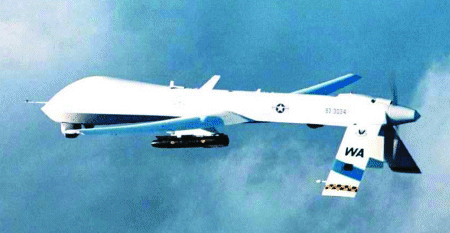US Air Force (USAF) and industry officials say initial weapons testing with the General Atomics Predator unmanned air vehicle (UAV) and laser-guided Lockheed Martin AGM-114 Hellfire missile against stationary ground targets produced mixed results, which they hope to rectify when flight demonstrations resume with firings from higher altitudes against moving targets.

Last February, the USAF successfully conducted a Phase I live-fire test of a Hellfire-armed RQ-1A Predator fitted with an AAS-44 turret incorporating a laser designator, a laser rangefinder and an infrared sensor. The weapon, fired from the UAV flying at an altitude of 2,000ft (600m), hit a stationary tank hull on the Nellis AFB range in Nevada. No physical constraints to arming the RQ-1A, which was not designed for weapons carriage, were encountered.
The USAF and General Atomics then initiated the more demanding Phase II effort in which the AAS-44 sensor was replaced by the more capable Raytheon Multi-Spectral Targeting System. A series of launches from higher altitudes were conducted in late May and early June against stationary targets, including a successful attempt from an altitude of 5,000ft.
Christopher Dusseault, General Atomics programme manager, declines to say how many missiles were fired and from what altitude, but Brig Gen Henry Obering, a senior USAF acquisition official, reveals that there have been 16 Predator/Hellfire launches, made from between 2,000ft and 15,000ft altitude. Obering says that the USAF is seeking to modify additional Predators for weapons testing.
Dusseault says testing to date has been "a mixed bag. We hit some, but missed some [targets]". Still to be determined is whether the 50kg (110lb) missile can be effectively launched from 15,000ft, where Predator normally operates. "The jury is still out on how the missile, which is not designed to be launched from high altitudes, will perform," he adds.
The tracker on the Raytheon prototype payload has been fine-tuned and the Phase II effort will resume when the test range is available. These tests will introduce moving ground targets. Successful testing could lead to the establishment of a requirement and a system development and demonstration programme.
The larger Predator B, which is in flight test, is powered by the Honeywell TPE331 turboprop. Company officials say that it could carry up to 16 Hellfire missiles. The RQ-1A is limited to two AGM-114 weapons.
Meanwhile, the USAF plans to conduct an advanced concepts technology demonstration (ACTD) in which Predator would launch mini-UAVs able to detect chemical/biological agents.
Source: Flight International























